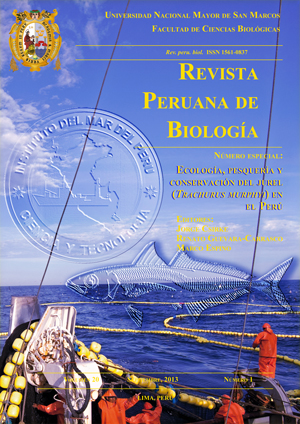Analysis of the Jack mackerel Trachurus murphyifishery in Peru
DOI:
https://doi.org/10.15381/rpb.v20i1.2625Keywords:
Jack mackerel, pelagic, Peruvian fishery, fishing effort, fisheries managementAbstract
There are records of the presence of Jack mackerel Trachurus murphyiin the artisanal fishery landings in Peru since 1907. Since 2000 Jack mackerel T. murphyicatches are ranked third after anchovy Engraulis ringensand jumbo squid Dosidicus gigas. Artisanal, industrial purse seine and offshore (factory trawlers) fleets take part in the Peruvian catches of T. murphyi. In 2011 the industrial purse-seine fleet with license to fish for T. murphyialong the Peruvian coast comprised of 62 industrial steel vessels (30177 m 3) and 42 industrial wood vessels (3082 m 3 ). Catches of T. murphyihad a significant increase after 1972, with maximum catches in 1977, 1996-97 and 2001, after which several years of low availability followed, with the lowest catches in 2010. However, this low availability trend was reversed in 2011, and catches reached almost 260 thousand tons that year. A general inverse relationship has been observed between the T. murphyiestimated acoustic biomass and the annual landings of anchovy E. ringensduring the the period 1972 – 2012. The monthly catches of T. murphyiby the industrial and artisanal fleets before 2002 were higher in the northern part of Peru (Mancora-Chimbote) while after 2002 the catches were higher in the south-central zone (Huacho-Ilo).Downloads
Downloads
Published
Issue
Section
License
Copyright (c) 2013 Miguel Ñiquen, Marilú Bouchon, Danny Ulloa, Ana Medina

This work is licensed under a Creative Commons Attribution-NonCommercial-ShareAlike 4.0 International License.
AUTHORS RETAIN THEIR RIGHTS:
a. Authors retain their trade mark rights and patent, and also on any process or procedure described in the article.
b. Authors retain their right to share, copy, distribute, perform and publicly communicate their article (eg, to place their article in an institutional repository or publish it in a book), with an acknowledgment of its initial publication in the Revista Peruana de Biologia.
c. Authors retain theirs right to make a subsequent publication of their work, to use the article or any part thereof (eg a compilation of his papers, lecture notes, thesis, or a book), always indicating its initial publication in the Revista Peruana de Biologia (the originator of the work, journal, volume, number and date).






